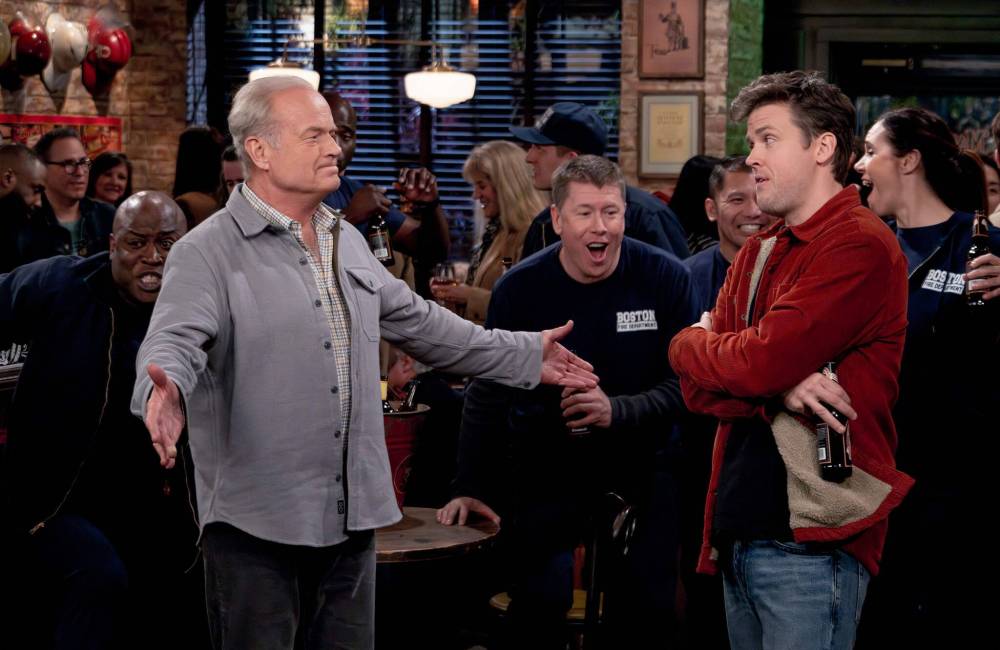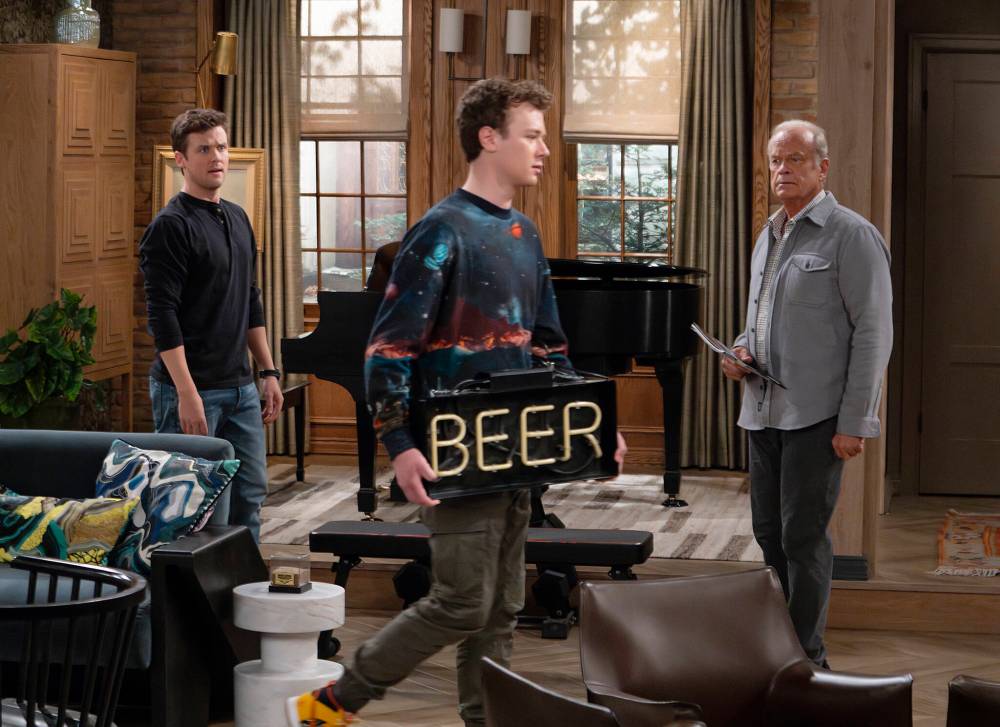Reboot? Spinoff? Superfluous?
On nostalgia and the return of Frasier Crane
Advertisement
Read this article for free:
or
Already have an account? Log in here »
To continue reading, please subscribe:
Monthly Digital Subscription
$0 for the first 4 weeks*
- Enjoy unlimited reading on winnipegfreepress.com
- Read the E-Edition, our digital replica newspaper
- Access News Break, our award-winning app
- Play interactive puzzles
*No charge for 4 weeks then price increases to the regular rate of $19.00 plus GST every four weeks. Offer available to new and qualified returning subscribers only. Cancel any time.
Monthly Digital Subscription
$4.75/week*
- Enjoy unlimited reading on winnipegfreepress.com
- Read the E-Edition, our digital replica newspaper
- Access News Break, our award-winning app
- Play interactive puzzles
*Billed as $19 plus GST every four weeks. Cancel any time.
To continue reading, please subscribe:
Add Free Press access to your Brandon Sun subscription for only an additional
$1 for the first 4 weeks*
*Your next subscription payment will increase by $1.00 and you will be charged $16.99 plus GST for four weeks. After four weeks, your payment will increase to $23.99 plus GST every four weeks.
Read unlimited articles for free today:
or
Already have an account? Log in here »
Hey there, time traveller!
This article was published 21/10/2023 (754 days ago), so information in it may no longer be current.
TV reboots — they’re like a magical monkey’s paw that grants your wish but only in some terrible way.
You think you want a reboot of one of your favourite shows, but you’ll probably end up regretting it.
Creators of this second go-round of Frasier (now streaming on Paramount+) are saying it shouldn’t be called a reboot. They’re calling it a spinoff of the first Frasier series, which ran from 1993 to 2004 on NBC and was itself a spinoff of Cheers. (The original show also streams on Paramount+, as well as Crave.)
Whatever you call it, though, the new series makes that paradoxical promise to deliver both nostalgia and freshness. Bringing back Kelsey Grammer as Frasier Crane, the pompous but likable psychiatrist, and dropping him into a different city with a different set of characters, the show ends up stranded awkwardly between old and new.
This 2023 version may be competent — Grammer is a practiced comic actor who can do a lot with a little — but it also feels a bit pointless.
The 10-episode season opens with Frasier, the one-time Seattle radio host, then Chicago TV star, back in Boston for what’s supposed to be a brief visit.
On the strength of Frasier giving one guest lecture at Harvard, the head of the psychology department there offers him a job, a plot development that had psych PhDs all over North America grinding their teeth. (Vulture had a hilarious bit where they emailed Ivy League academics, who soberly explained why Frasier Crane wouldn’t be “a good fit” for their program unless he could show a record of peer-reviewed publications and a proven ability to bring in research funding.)
Frasier decides to stay in Beantown, partly because he’s keen “to inspire young minds” — though his opening references to Dante don’t seem to be landing — but mostly because he wants to reconnect with his adult son Freddy (now played by Jack Cutmore-Scott).
The original series often saw bluff, blue-collar Martin Crane (the late, great John Mahoney) in comic conflict with his effete, elitist sons, Frasier and Niles (David Hyde Pierce). This class warfare was symbolized by placing Martin’s duct-taped Barcalounger next to Frasier’s replica of Coco Chanel’s couch.

Chris Haston / Paramount+
Kelsey Grammer once again plays Frasier Crane, this time sharing an apartment with son Freddy (Jack Cutmore-Scott).
The new series clearly hopes to replicate that dynamic but flips the generational class divide the other way. This takes a bit of retroactive tinkering: in the original series, Freddy was a delicate, painfully precocious boy — when he had childhood nightmares about a monster in his closet, it was the racist Republican Sen. Strom Thurmond.
The grown-up Freddy, on the other hand, is a beer-drinking, sports-loving, regular-guy firefighter.
When father and son, through some easily engineered sitcom shenanigans, end up sharing an apartment, it’s now Freddy’s cube of Fenway Park dirt that Frasier is reluctant to mix with his Christian Lacroix pillows and Viennese Art Nouveau vases.
Likewise, the writers’ room attempts to fill the comedy vacuum left by the absent Niles (Pierce tactfully declined to reprise his role), Frasier’s companion in wine snobbery and arcane opera facts, with not one but two stand-ins. Niles and Daphne’s son David (Anders Keith), a Harvard undergrad who says things like, “My ire is piqued,” supplies the uptight fussiness, while Frasier’s tweedy, boozy, snooty colleague Alan (ably played by Nicholas Lyndhurst) offers the slightly competitive carping that made Frasier and Niles’ coffee dates perk.
At Frasier’s workplace, there’s some comic friction with his ambitious boss, Olivia (Toks Olagundoye). At home, there are some low-key misunderstandings with Freddy’s friend Eve (Jess Salgueiro). But so far there doesn’t seem to be any effective replacement for wisecracking Roz (Peri Gilpin) or cheerfully wacky Daphne (Jane Leeves).
Like many reboots, the show also features a lot of little callbacks to the original. The first episode, for example, is titled The Good Father, a reference to the original series’ première episode, The Good Son.

But these callbacks might work too well. At one point, Frasier comments that he’s “no stranger to an underperforming dinner party,” which gets a big response from the live audience. That got me thinking about all the entertaining disasters in the old show — all the complicated misdirection and deception, all the slapstick chaos, all the dropped plates and constantly changing guest lists involved in the Crane crew’s holiday celebrations and swanky soirées.
I’ve now abandoned the new series. I’m rewatching the original instead.
alison.gillmor@winnipegfreepress.com

Studying at the University of Winnipeg and later Toronto’s York University, Alison Gillmor planned to become an art historian. She ended up catching the journalism bug when she started as visual arts reviewer at the Winnipeg Free Press in 1992.
Our newsroom depends on a growing audience of readers to power our journalism. If you are not a paid reader, please consider becoming a subscriber.
Our newsroom depends on its audience of readers to power our journalism. Thank you for your support.



